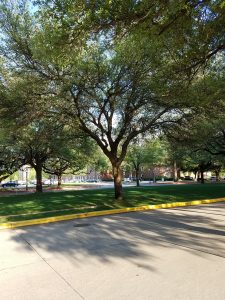Bishop Boulevard
As you’re taking a stroll down Bishop Boulevard on the campus of Southern Methodist University, stop a moment to enjoy the stately trees that line the avenue.  There are many different aspects of trees that one can look at from a mathematical persepctive, but we’re going to take a look at how the tree branches, from a point of view similar to the one we used at the Centennial Fountain. One can easily see that there are more and more branches as you progress from the trunk toward the leaves, but why do they become thinner and thinner? You could say that it’s for structural reasons, but you could certainly design a stable structure that did not become thinner at the extremities, like a coatrack. On the other hand, if we think about what’s going on inside those branches, we can get more of a handle on how they become smaller. Namely, the tree’s sap needs to carry nutrients back and forth between the roots and the leaves. So if we think of the branches as a sort of plumbing system that connects the two, which says that the fluid carrying capacity of the trunk should roughly match the total fluid carrying capacity of all of the branches at any level of the tree. This has led researchers to formulate a rough principle that the total cross-sectional area of all of the branches crossing any cross-section of the entire tree should be the same no matter where that cross section is taken. Many real trees come close to fitting this intuitive model, which allows you to quantitatively understand why and to what degree the branches become thinner as you move toward the leaves of the tree.
There are many different aspects of trees that one can look at from a mathematical persepctive, but we’re going to take a look at how the tree branches, from a point of view similar to the one we used at the Centennial Fountain. One can easily see that there are more and more branches as you progress from the trunk toward the leaves, but why do they become thinner and thinner? You could say that it’s for structural reasons, but you could certainly design a stable structure that did not become thinner at the extremities, like a coatrack. On the other hand, if we think about what’s going on inside those branches, we can get more of a handle on how they become smaller. Namely, the tree’s sap needs to carry nutrients back and forth between the roots and the leaves. So if we think of the branches as a sort of plumbing system that connects the two, which says that the fluid carrying capacity of the trunk should roughly match the total fluid carrying capacity of all of the branches at any level of the tree. This has led researchers to formulate a rough principle that the total cross-sectional area of all of the branches crossing any cross-section of the entire tree should be the same no matter where that cross section is taken. Many real trees come close to fitting this intuitive model, which allows you to quantitatively understand why and to what degree the branches become thinner as you move toward the leaves of the tree.

